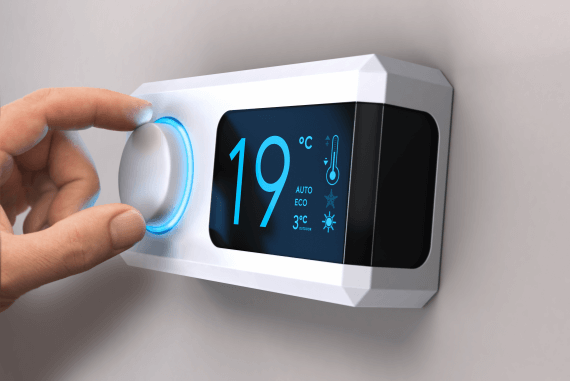- Home ››
- Health and Safety Training ››
- Environmental Health and Safety ››
- Adjusting Heating and Cooling
Adjusting Heating and Cooling

Heating and cooling air in a building through heaters, radiators and air conditioning units requires a tremendous amount of electricity to accomplish. Unless this electricity is generated through environmentally-friendly means such as wind or solar, it will likely have been produced through burning fossil fuels which causes pollution and damages the environment. Raising and lowering the temperature of a room can therefore have serious consequences for the environment and the health, safety and well-being of all living creatures. When taken at a global level, this heating and cooling can have dramatic effects on the planet as a whole because of the cumulative effects of the pollution created through this electricity demand.
One thing to keep in mind then is the intended occupancy and activities that are shortly to take place in the room, as this can have massive effects upon the temperature levels and subsequently the amount of heating or cooling that will then be necessary to bring the temperature back to a comfortable level. Forward planning and forethought can play a big part in this achievement. For example, consider a village hall which is heated to a consistent level but knows that shortly it will host a keep-fit session which will fill the room with lots of people who are exercising and so producing a lot of body heat. In this scenario, there is no point in heating the room to normal levels when pretty soon after starting the room will be far too hot and windows will need to be opened to let hot air out or maybe even air conditioning units to be activated. Not only will previously heated air be let out of the windows, but previously heated air may even then need to be cooled down by the air conditioning units! This is a horrible waste of energy which will contribute to pollution levels.
With a bit of forethought and forward planning, the heating level will be greatly reduced or even switched off completely beforehand in anticipation of the keep-fit event. Whilst is may be a bit cold and chilly initially, it will soon heat up when exercising commences and will not require previously heated air to be expelled.
How Interference with Thermostats Can Be Bad for the Environment
Everybody knows that buttons, switches and control panels can be extremely tempting to fiddle with, especially for children, and thermostats are no exception. With the knowledge that messing with it will not cause catastrophe as it might were they to play with a serious looking control panel, it can be even more alluring to just move the thermostat about simply because it is there and within reach. It may also provide a source of amusement for adults who should know better to perform a practical joke by turning the thermostat right up to maximum or to its lowest setting.
Whilst the consequences are unlikely to be anything more than mild annoyance for the owners of the building, we know how small changes to a thermostat can have cumulative effects. For example, turning the thermostat down by just one degree could cut energy bills by up to 10% each year and with one degree being barely noticeable, any interference or fiddling with the thermostat by just a slight amount may go unnoticed and result in higher energy consumption and heating costs over a considerable period of time. Along with the financial implications for the bill payer, the increased energy consumption can be bad for the environment if that electricity is produced through burning fossil fuels.
As is the case with other environmental actions, a single thermostat is not going to have much effect upon the health of the planet or global pollution levels. However, the cumulative effects of all the other thermostats in the world which are set slightly higher than they could be will result in a dramatic effect upon energy consumption levels and, consequently, pollution levels as a by-product of generating this electricity.
How Can Thermostat Levels Be Maintained?
The best way of preventing unwanted changes to thermostats is to locate them away from public areas such as in a basement or in a room where the public are not allowed. If this is not possible then covers can be fitted over the top which require a key to open and so prevent unauthorised adjustment of the thermostat and temperature controls. Along with thermostats, this is also good practice for other controls and switches for other devices, with the obvious exception of emergency stop buttons of course which need to be in reach for anyone to press. Whilst they may sometimes be subject to misuse, it is necessary for them to be available should the need arise to stop a process in an emergency situation, without having to wait for someone with a key to come.
Conclusion
So whilst it may not seem much in the grand scheme of things, keeping the thermostat temperature down a little lower, and taking steps to avoid over-heating or unnecessary heating of a space, can have a positive environmental effect if everyone were to do it. It may not be a big event such as replacing an entire coal burning power station with a cleaner alternative, but it is an action which, if taken by a large number of people, has a significant cumulative impact.
It is one of those seemingly insignificant actions like switching to energy efficient light bulbs or even painting a room a different colour that on its own will not make much of a difference, but if everybody does it, then it will have major benefits for the environment. As an illustration of this point, if every home in America replaced just one of their light bulbs to an energy efficient one, it would lead to a reduction in greenhouse gas emissions to the equivalent of 800,000 cars (Source: SFGATE).
Both personal households and businesses have a responsibility for conserving energy and reducing the demand for power. Whether this is through adjusting the temperature on a thermostat or by other means, a reduction in power demand with require less resources to be consumed in generating that electricity.

